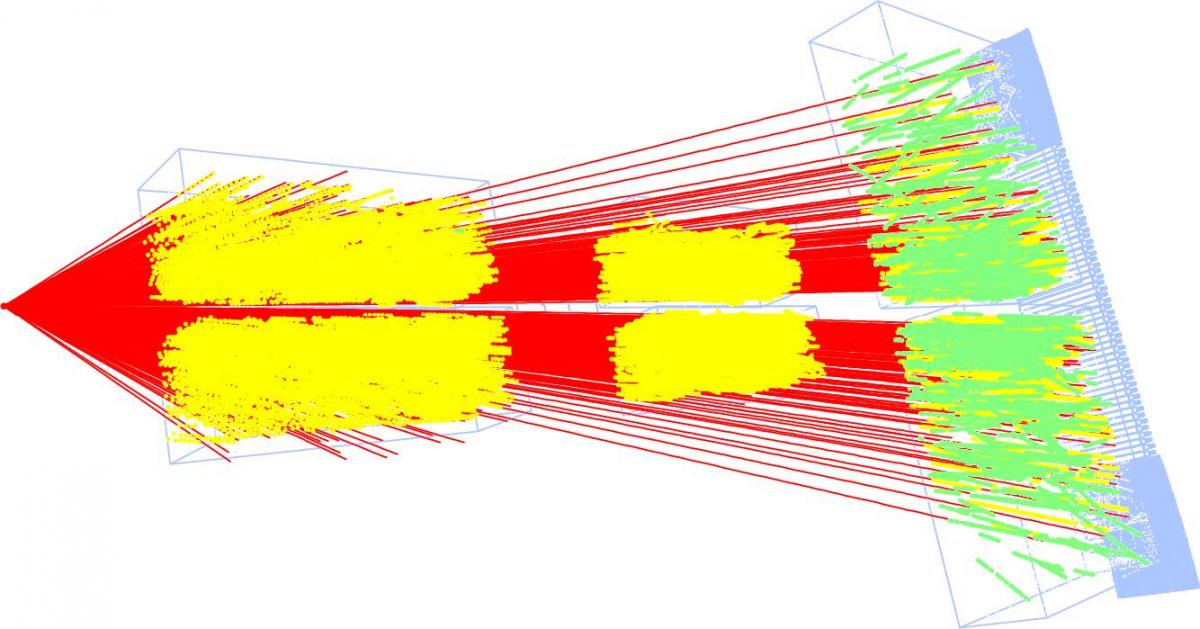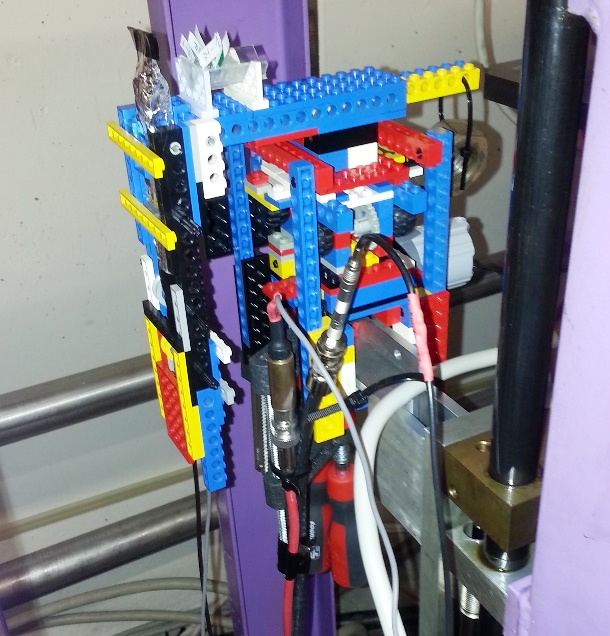First Pb beam in NA61/SHINE
December 1st ended a two-week test period with Pb beam in the NA61/SHINE fixed-target experiment [1]. Pb ions at momentum of 30A GeV/c were delivered from the CERN SPS to the experiment for the first time. The beam time was used to perform numerous test and calibration measurements. They are needed to prepare for the beam momentum scan with Pb+Pb collisions requested by NA61/SHINE [2] to take place in 2016 and 2018. The scan is expected to deliver important results on the beam momentum dependence of collective effects due to strong and electromagnetic interactions, fluctuations and open charm production in minimum bias and central Pb+Pb collisions.
Both super-conducting magnets of the experiment, VTX-1 and VTX-2, were switched-off. In September 2015, caused by a cryogenic system malfunctioning, three fast discharges of the VTX-1 magnet occurred. It was concluded that further operation of both magnets will require a new magnet safety system which will be constructed by CERN PH-DT and installed in April 2016. Cooling down of the magnets is planned in March-April 2016 and then tests of the repaired cryogenic system and the VTX-1 magnet will be performed. They will allow to conclude on any possible damage of the magnet and to plan its repair.
During the 2015 test period two million Pb+Pb collisions were recorded with the help of a new minimum-bias trigger detector. They will allow to examine the capabilities of the Projectile Spectator Detector (PSD) calorimeter to measure the reaction plane. The PSD data will be correlated with tracks measured in the Time Projection Chamber (TPC) system in order to determine v1 and v2 flow coefficients as a function of pseudo-rapidity. The detector, data acquisition and data transfer operated successfully during these challenging measurements of high multiplicity and large size events.
To measure short-lived open charm D0 and D0bar mesons NA61/SHINE is developing a new Vertex Detector based on the CMOS Monolithic Active Pixel Sensor MIMOSA-26. One MIMOSA-26 was operated in its future nominal position and its response to the high track multiplicity of Pb+Pb collisions was tested. Moreover, to study potential vulnerabilities to Pb ions during operation, the sensor was operated directly in the Pb beam.

Figure 1: Central Pb+Pb collision at 30A GeV/c reconstructed in the NA61/SHINE detector in November 2015.
Individual latch-ups, which manifest themselves as reversible short circuits within CMOS chips, were observed. They were recovered by power cycling the sensor with a recently introduced, semi-automatic recovery system. The sensor was found to operate reliably and without obvious performance losses even once it was directly exposed to the primary beam for 24 hours. The second test aimed to study the bulk damage caused by Pb ions in the active volume of CMOS sensors. Several samples were placed in the high beam intensity region of the H2 beam-line, 250 meters upstream the NA61/SHINE target.

Figure 2: Irradiation station of CMOS sensors. The irradiated samples and a scintillation counter are visible on the top of the Lego support.
They were irradiated with up to 1.2 x 1010 Pb ions/cm2. Figure 2 shows the samples under irradiation and a scintillation counter serving for dosimetry. Both were held by a positioning table made from Lego cubes, which could be controlled from outside the beam area. The Lego cubes allowed for a very fast and flexible assembly of the positioning table needed due to a limited access to the H2 beam-line.
For the future data taking for open charm production it is crucial to have a high intensity and well collimated Pb beam. Thanks to combined efforts of CERN and NA61/SHINE teams, a Pb beam of width smaller than 1 mm at the NA61/SHINE target was produced. The maximum beam intensity allowed by the present radiation protection of the H2 beam-line was found to be about 800000 Pb ions during 10 s extraction from SPS.
The Projectile Spectator Detector underwent several test and calibration measurements. Data taking with Ar+Sc collisions in winter 2015 revealed several potential weaknesses of the detector when exposed to Pb beams.
They were corrected by addition of a new module minimising the shower leakage, replacement of MAPD light detectors with faster MPPC sensors, and fine tuning settings of the amplication electronics for the best resolution and dynamic range. The modications enhanced the energy resolution and proved that the PSD will be ready for data taking with Pb+Pb collisions.
The beam period was completed with the first test of scintillating fibres with Pb ions. The fibres will be used to build new, faster Beam Position Detectors (BPD), which could be placed in vacuum, as opposed to the currently used wire chambers.
The two weeks of Pb ions allowed for a thorough test of the NA61/SHINE detector and ongoing upgrades. It was needed to ensure success of the beam momentum scan with Pb+Pb collisions in 2016 and 2018. Moreover, first proposals for the experimental programme past Long Shutdown 2 are being considered, which would require to increase the data acquisition rate by a factor of 10-20. The tests performed this year allow us to look condently into the future beyond 2020.
References
[1] N. Abgrall et al. [NA61/SHINE Collaboration], NA61/SHINE facility at the CERN SPS: beams and detector system, JINST 9, P06005 (2014) [arXiv:1401.4699 [physics.ins-det]]
[2] A. Aduszkiewicz et al. [NA61/SHINE Collaboration], Beam momentum scan with Pb+Pb collisions, CERN-SPSC-2015-038; SPSC-P-330-ADD-8
